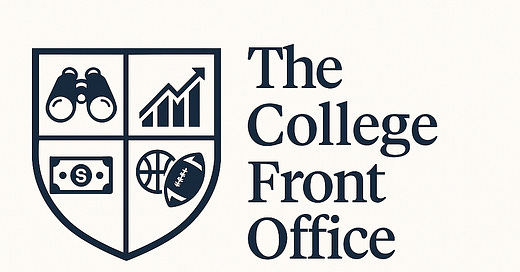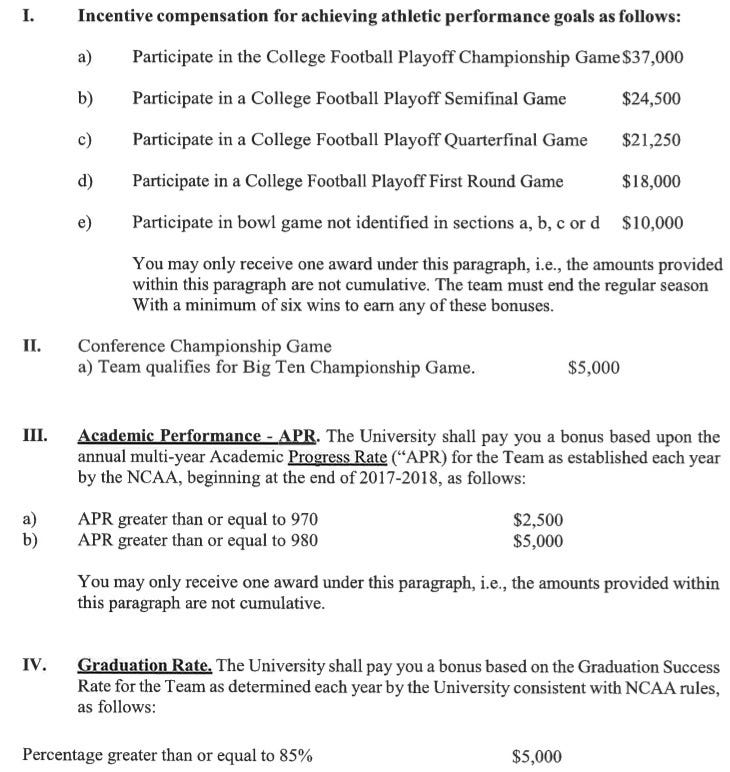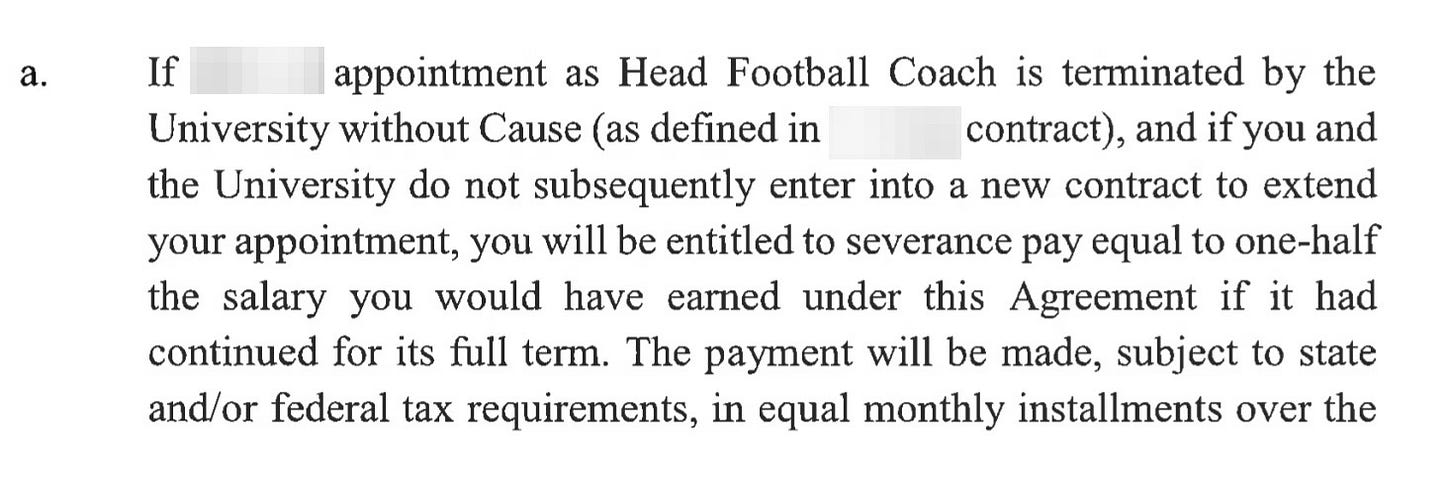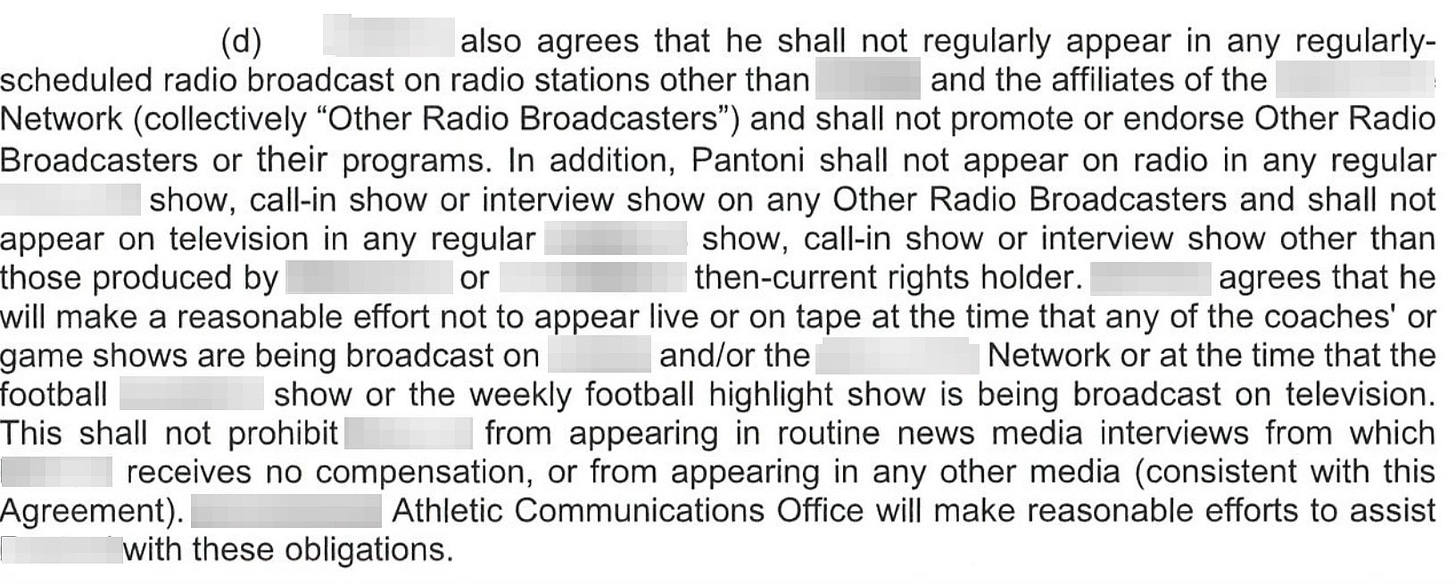TERMS: A Deep Dive into Big Ten Football GM Contracts
From $200K to nearly $1M a year: these terms are landing top college football GMs
Happy Thursday, everyone!
Today is the general release of EA Sports College Football ‘26. One of the rare instances where I have seen fans en masse laud the implementation of NIL rights within college sports. Take your victories where you can get them, I suppose.
While we all pretend to be GMs in dynasty mode, many across the country are playing dynasty mode in real life. Losing a star player to the transfer portal stings in the game, but imagine picking up the pieces of a fractured program when your butt is on the line — maybe a bit less glamorous of a job IRL than behind the sticks.
That said, many of you, video games or not, are wondering “how I can do this in real life”… how can I make a living by knowing ball (and negotiations, player management, cap strategy, plus a handful of other skills).
Rest assured, these positions exist, and while the scope of “what does it take to land one of these jobs” will be left for another article, I will show you today just how lucrative these positions can be within the highest levels of college sport.
Earlier this week, I investigated Group of Five GM contracts, as you will see, those figures are very modest in comparison to the Big Ten. No surprises there.
Everything related to these contracts is escalated to the power conference level. Salaries, buyouts, perks, and term length all grow substantially. There is a great deal of security once you make it to this level; however, it is essential to keep in mind that there are fewer Power 4 football GMs than U.S. Senators.
If you are confused about just what a GM is, or why they are popping all over the college sports landscape, this article has some helpful background.
Let’s dive in, shall we?
Big Ten Conference GM #1 (Winning Conf. Record 2024)
Term: 2 years
Base Salary: $250,000
Signing Bonus: $12,500
Fringe Benefits: Tickets to all university athletics events and the permissive ability for the athletics department to provide a courtesy vehicle to the GM.
Incentive Bonus: Maximum $315,000 (126% of base salary) — Out of all the contracts I have reviewed, this is the only one that has incentive bonuses that could exceed the GM’s base salary. One massive CBB GM deal, which I showed on X, had incentives that could reach roughly 67% of base salary; that was the record until now. This school more than doubled it!
I have seen a lot of discourse on social media discussing how GMs shouldn’t earn incentive money from the success of the coaching staff. I find that to be a bit misguided. If an athletics department is willing to spend hundreds of thousands, or as we will later see, over a million dollars per year on a GM, they must believe that scouting, rev-share negotiation, and cap management play a pivotal part in the success of a modern program.
A great chef can only do so much with low-quality ingredients.
Termination/Liquidated Damages: GM is bound by a unique buyout provision within its contract ($500,000 payout cap). How much of the payout cap is levied against the GM is predicated on who his next employer is. If the job the GM leaves for is non-football specific and within an athletic department, they owe $20,000; if it is another GM position within football (college or professional), they will owe $250,000, however, if the position is within the Big Ten conference the full $500,000 buyout penalty will be enforced. Steep.
Big Ten Conference GM #2 (Winning Conf. Record 2024)
Term: 1 year *This is the only P4 contract I have seen with a one-year term*
Base Salary: $400,000
Signing Bonus: $10,000; If the GM resigns before December 1, 2025, $5,000 of the bonus must be repaid to the university.
Fringe Benefits: Standard benefits of an assistant coach, plus a $400 monthly car stipend
Incentive Bonus: Maximum of $52,000 (13% of base salary):
Termination/Liquidated Damages: Within a good amount of GM contracts, employment is teathered to the presence of the head coach. In this instance, the departure of the head coach leads to immediate termination of the GM; some contracts give the AD only the right to terminate the contract.
The method by which the head coach leaves determines the amount of severance pay. If the head coach is fired without cause, the GM will earn 50% of the remaining compensation under the agreement, with a duty to mitigate. If the head coach leaves or is fired with cause, only one month of pay will be distributed.
Additionally, if the university terminates the GM's contract without cause, GM will be entitled to 50% of the remaining compensation with a duty to mitigate.
Big Ten Conference GM #3 (Winning Conf. Record 2024)
Term: 3 years
Base Salary: $900,000 (yr. 1); $925,000 (yr. 2); $975,000 (yr. 3)
Fringe Benefits: Tickets to home sporting games (can not resell)
Incentive Bonus: Maximum $458,250 (47% of yr. 3 base salary)
Conference Championship Appearance: 8% of base salary (12% if win)
CFP: Round-one loss 10% of base salary; round-two loss 20%; semi-finals loss 25%; championship game loss 30%; championship game victory 35%
Termination/Liquidated Damages: If terminated by the GM before December 1, 2027 (end of yr. 2) for employment within an NCAA Division 1 program or an NFL organization, the GM will owe 30% of their salary as a buyout, approximately $300,000.
This is a unique provision I would anticipate getting thrown into more GM contracts moving forward:
“[GM] shall not for a period of one (1) year after such termination by [GM] contact or otherwise seek to recruit any high school athlete previously contacted or recruited by [School], unless such athlete had been recruited or contacted by any new institution employing [GM] prior to the notice of termination by [GM] to [School].”
GM is only entitled to continued compensation if he is fired before December 31, 2027. Effectively, this creates an option for the school to exercise within the contract before GM hits the $975,000 year three salary. In any instance, GM can only earn the lesser of 24 months' worth of pay or the remaining compensation owed for the term. Any severance pay earned by the GM is subject to a duty to mitigate.
One unique provision found is the permissive ability for the coach to appear on local radio. Most contracts require all endorsement deals and media appearances to be given the blessing of both the head coach and athletics director; however, this is waived in the contract for one local affiliate.
Big Ten Conference GM #4 (Losing Conf. Record 2024)
Term: 3 years
Base Salary: $800,000 (yr. 1); $850,000 (yr. 2); $900,000 (yr. 3)
Fringe Benefits: $25,000 moving expense, “eligible to receive all the fringe benefits that the University offers to its managerial-professional staff members, as well as any additional fringe benefits that may be approved by the Athletic Director.”
Incentive Bonus: Maximum $225,000 (25% of yr. 3 base salary):
Termination/Liquidated Damages: If the GM is terminated without cause, the university will owe the GM their base salary for the remainder of the term, with the GM having a duty to mitigate. The contract, like most, includes specific notice to prohibit GM from avoiding mitigation payments by structuring payments with another employer beyond the term of its current contract.
If GM is to resign or leave for another opportunity, they will be responsible for a buyout only within the first two years of the term.
I have realized that I often talk about for cause, but don’t show how schools outline what qualifies as a termination for cause. I will leave it below if you care to read how this school articulates a rightful firing:
As with any public institution, any deprivation of life, liberty, or property is subject to due process. Accordingly, the contract sets forth procedures for addressing grievances arising from any adverse action taken against the GM:
Big Ten Conference GM #5 (Losing Conf. Record 2024)
Term: 2 years
Base Salary: $200,000
Fringe Benefits: Courtesy vehicle or $500 monthly car stipend; $25,000 moving expense
Incentive Bonus: Maximum $62,000 (31% of base pay). Any incentive payout is contingent on the team maintaining an APR score of 930.
Termination/Liquidated Damages: If terminated without cause, GM will earn the remainder of the money owed in his contract with a duty to mitigate.
If the GM decides to leave in the first season they will owe a $200,000 penalty; if GM leaves in season two, they will owe the lesser of $120,000 or the remaining salary owed to the GM.
Once again, if the head coach is terminated, the Athletic Director will hold the ability to terminate the GM agreement. GM will be owed the lesser of three months salary or the remaining amount owed on his contract.
The school executed a buyout to acquire this GM, paying the full amount owed to the GM’s previous institution. The contract also specifies that the school’s fulfillment of this buyout does not constitute taxable income to the GM.
In Conclusion
I hope you found some of these deep dives interesting. I will continue to release more contracts over the next month; however, I will shift my efforts onto other areas of interest in the college sports world: revenue streams, mental health, due process, amongst other things I care about.
More to come!
Thank you for following along: feel free to subscribe, share, and connect with me. The support I have recieved over the past month has been incredible and I am thrilled to be working on building The College Front Office. Peace.
Noah Henderson is the Director of the Sport Management Program and a Clinical Instructor at Loyola University Chicago’s Quinlan School of Business. His work explores the intersection of law, economics, and the social consequences of college athletics, particularly in the areas of name, image, and likeness (NIL), athlete labor rights, and sports gambling.
Henderson helped amend Illinois’ NIL legislation and played a direct role in establishing early frameworks that facilitated the legal payment of college athletes at Student Athlete NIL. He continues to advise athletic departments, brands, and sports agents nationwide on NIL policy, legal compliance, and best practices.
He contributed extensively to Sports Illustrated’s NIL Daily, where his reporting and commentary helped shape public understanding of the evolving business of college athletics. His insights have been featured by ESPN, NPR, CNN, PBS, Sportico, the Chicago Tribune, and others.
Henderson holds a Juris Doctor from the University of Illinois College of Law and a degree in Economics from Saint Joseph’s University, where he was a four-year letter winner on the golf team.



















